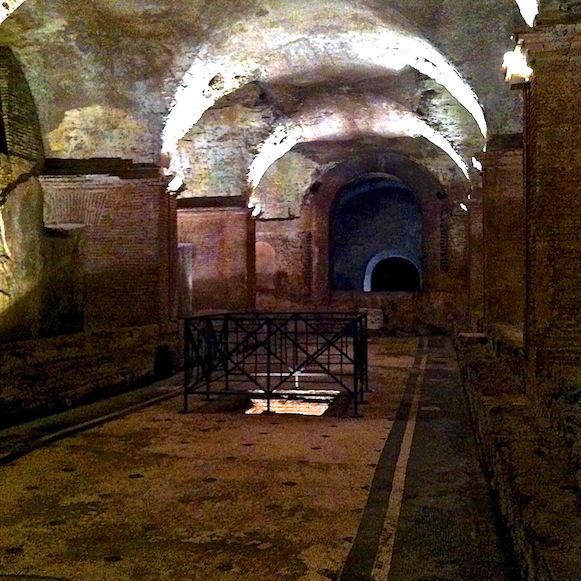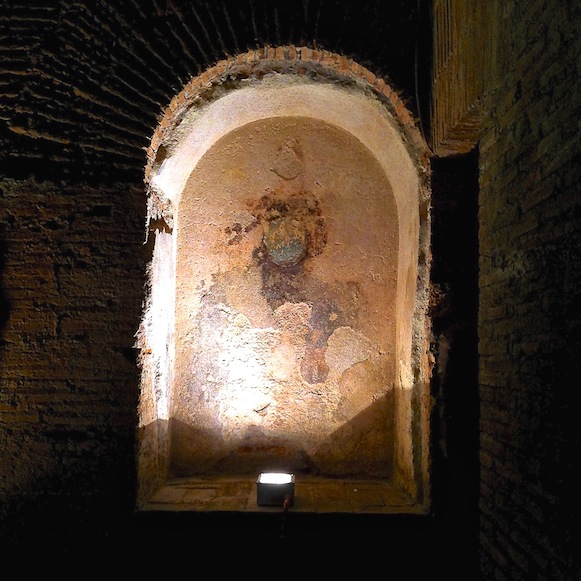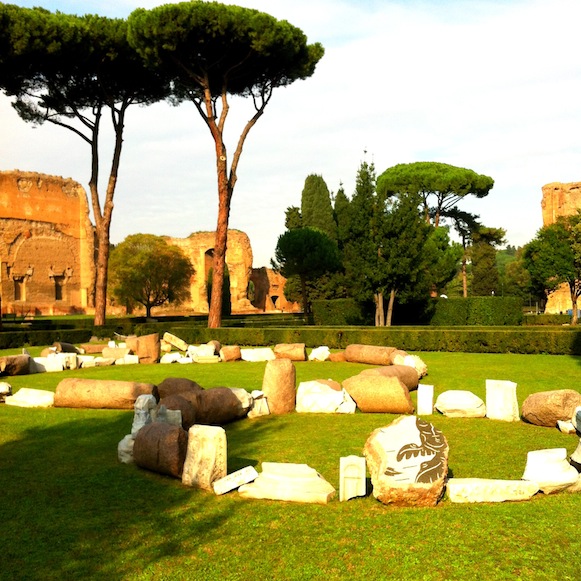Mithraeum at the Baths of Caracalla
Any time an ancient site opens, or better yet, reopens, it is a cause for celebration. Once again, we are permitted to literally step into history and equally watch as history makes itself thanks to continued cultural heritage endeavors and financial support. This is especially the case with the recent opening of the Mithraeum of the Baths of Caracalla. Originally discovered in 1912, this mithraeum is considered the largest documented gathering space for the worshippers of Mithras. (Mithras was a Persian god in vogue with the military and mostly lower class men, in the second and third centuries AD.) The mithraeum, approximately 23 meters long and 10 meters wide with a soaring cross-vaulted ceiling, can be only roughly dated by the two main events associated with the bath complex: the mithraeum was certainly created after the complex was completed in AD 217, and it was probably no longer in use when the aqueduct supplying the complex was cut during the Greco-Gothic Wars in 537. In reality, it probably went out of use long before 537, since most scholars hold that Christianity had supplanted Mithraism as a “religion for the masses” by the early 4th century.
Today, a visit to the mithraeum can be considered a brief one, as what is available to us are primarily two chambers: a small square ante-chamber and the main rectangular meeting hall. Apart from a recently-restored fresco of the god (missing the face, unfortunately – presumably hacked away by Christians), there is very little left of the decoration, which was probably very lavish. The well-preserved podium structures on either long side, on which the worshippers reclined during ritual meals, give an excellent idea of the context and purpose of the shrine. Certainly the most intriguing feature is the small tunnel that runs under the center of the main hall into an adjoining room, where there is an entrance/exit with staircase; this has been identified with some controversy as the fossa sanguinis, the ritual pit over which the bull at the center of the Mithraic mythology was slaughtered, bathing one or more initiates in its blood.
Its location, off a dirt road adjacent to the main entrance, is part of a subterranean area of the Baths of Caracalla. The mithraeum space is just one part of the massive, sprawling system of underground corridors that honeycombs the large artificial platform supporting the Baths of Caracalla. Beneath the thermae complex lies a warren of tunnels with furnaces, stoked by slaves, and storage areas for supplies, including wood. Though access to these tunnels is today only partial, there are confirmed plans to extend the conservation and restoration work to make more of these areas accessible, including a substantial area dedicated to grinding grain using the water that passed through the baths.
It is important to note that Rome and its port city Ostia Antica have the largest number of preserved mithraea of any city in the Roman empire—scholars estimate that Rome once had 700 Mithraic shrines, while Ostia boasts 17 confirmed shrines—but only a small percentage of these are accessible to the public. More money and more investment will only benefit conservation and access for tourists who are increasingly willing to explore the more remote corners of the ancient city.
Visiting the Mithraeum is also an excellent excuse to head into the Baths of Caracalla to walk among the monumental structure and also enjoy a contemporary art installation by Italian artist Michelangelo Pistoletto. Three interlocking circles made up of fragrments of ancient marble and stone, Terzo Paradiso is the new symbol of infinity created by Pistoletto originally for the 2005 Venice Biennale, and an ongoing, collaborative project in varying venues and media. The new infinity symbol is all to action for the active and conscious need to create a “third paradise” to combat and transplant the artificial world we are celebrating today. Too deep? Too artsy? In any case, the site specific installation (through January 6, 2013) is a beautiful juxtaposition of contemporary and ancient, especially with the backdrop of the majestic pines and Baths of Caracalla.
How to visit: advance reservation for a guided tour to Mithraeum at the Baths of Caracalla will cost 16.50 euro and does not include entrance to the Baths. Here’s a tip- try the unguided visits at 10:00, 10:30, and 1:00, which are practically empty on weekdays. How? Buy the regular ticket (6.00 euros) at the ticket booth and pay a 1.50 euro supplement to visit the Mithraeum at one of those three times.
Freeze Frame: Art History on site

Throughout our journey here in Rome, we’ve seen some of the most valuable pieces of art in the world, and because we had an amazing guide, we were able to not only view them, but to appreciate their stories and structures as well. It’s interesting that many question the financial background of the Catholic Church when, as our guide stated, the most invaluable piece owned by the Church could be sold for millions of dollars. This post will mainly focus on the artists that influenced some of Rome’s greatest pieces, all of which had a religious undertaking.
One area of Rome that our group thought was particularly amazing was the Piazza Navona, which features sculptures by Gian Lorenzo Bernini. We found Bernini’s work mind-blowing due to his ability to capture a narrative moment in marble. He had four major pieces in the Borghese Gallery; our favorite was Apollo e Dafne, which depicts the god Apollo chasing his love, the wood nymph Daphne, and her subsequent metamorphosis into a tree. Bernini flawlessly captures the love that Apollo feels for Daphne through his gentle touch around Daphne’s waist, while also perfectly portraying Daphne’s anguish through her expression—a distinctly Baroque style of showing emotion. As we stated, Bernini is known for capturing moments at their physical and emotional heights, and Daphne’s transformation is no exception, with leaves sprouting from her fingers, roots growing from her toes and roughly polished marble bark wrapping around her body.
When we made our way through the Borghese Gallery, one artist stuck out to us among the rest: Caravaggio. Learning about how different Caravaggio was compared to the other artists of his time sparked our interest. Caravaggio had a different feel, a darker, more realistic approach to his paintings that all of us had a great appreciation for.
Raffaello Sanzio da Urbino, better known as Raphael, is responsible for many works of art, most notably School of Athens, which now hangs in the Vatican Museums. School of Athens shows different philosophers expressing their philosophies, including Aristotle, Plato, Pythagoras, Socrates and even Raphael himself. We also found it interesting that Michelangelo is painted into the scene.
Speaking of Michelangelo, he created the Sistine Chapel! Nearly everyone knows about the Sistine Chapel, and, upon discovering that our itinerary included a visit to the Chapel, we were so excited to be able to say that we had seen it in the flesh. Like many galleries, no pictures were allowed in the Chapel (although we spotted many tourists taking pictures anyway). Michelangelo was simply a genius and it was great to see a work that is widely considered the epitome of his career.
Our time in Rome has been filled with tons of memories and life lessons. We’ve learned so much about the art history behind Rome, as well as other aspects of the city’s rich history. This has been a trip of a lifetime, and the galleries and artists mentioned above have helped to make our time educational and worthwhile.
–Lauren Sears, NEURome12
Research Assistant
Interdisciplinary Affective Science Lab Northeastern University
Want to know what else these NEU students are doing? Take a peek on Twitter: #neurome12














